Kaist
Korean

News
College of Engineering News
-
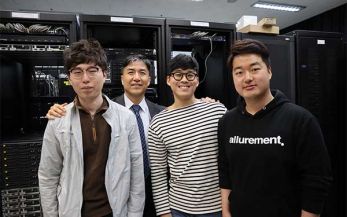
KAIST Unveils the Hidden Control Architecture of B..
(Professor Kwang-Hyun Cho and his team) A KAIST research team identified the intrinsic control architecture of brain networks. The control properties will contribute to providing a fundamental basis for the exogenous control of brain networks and, therefore, has broad implications in cognitive and clinical neuroscience. Although efficiency and robustness are often regarded as having a trade-off relationship, the human brain usually exhibits both attributes when it performs complex cognitive functions. Such optimality must be rooted in a specific coordinated control of interconnected brain regions, but the understanding of the intrinsic control architecture of brain networks is lacking. Professor Kwang-Hyun Cho from the Department of Bio and Brain Engineering and his team investigated the intrinsic control architecture of brain networks. They employed an interdisciplinary approach that spans connectomics, neuroscience, control engineering, network science, and systems biology to examine the structural brain networks of various species and compared them with the control architecture of other biological networks, as well as man-made ones, such as social, infrastructural and technological networks. In particular, the team reconstructed the structural brain networks of 100 healthy human adults by performing brain parcellation and tractography with structural and diffusion imaging data obtained from the Human Connectome Project database of the US National Institutes of Health. The team developed a framework for analyzing the control architecture of brain networks based on the minimum dominating set (MDSet), which refers to a minimal subset of nodes (MD-nodes) that control the remaining nodes with a one-step direct interaction. MD-nodes play a crucial role in various complex networks including biomolecular networks, but they have not been investigated in brain networks. By exploring and comparing the structural principles underlying the composition of MDSets of various complex networks, the team delineated their distinct control architectures. Interestingly, the team found that the proportion of MDSets in brain networks is remarkably small compared to those of other complex networks. This finding implies that brain networks may have been optimized for minimizing the cost required for controlling networks. Furthermore, the team found that the MDSets of brain networks are not solely determined by the degree of nodes, but rather strategically placed to form a particular control architecture. Consequently, the team revealed the hidden control architecture of brain networks, namely, the distributed and overlapping control architecture that is distinct from other complex networks. The team found that such a particular control architecture brings about robustness against targeted attacks (i.e., preferential attacks on high-degree nodes) which might be a fundamental basis of robust brain functions against preferential damage of high-degree nodes (i.e., brain regions). Moreover, the team found that the particular control architecture of brain networks also enables high efficiency in switching from one network state, defined by a set of node activities, to another – a capability that is crucial for traversing diverse cognitive states. Professor Cho said, “This study is the first attempt to make a quantitative comparison between brain networks and other real-world complex networks. Understanding of intrinsic control architecture underlying brain networks may enable the development of optimal interventions for therapeutic purposes or cognitive enhancement.” This research, led by Byeongwook Lee, Uiryong Kang and Hongjun Chang, was published in iScience (10.1016/j.isci.2019.02.017) on March 29, 2019. Figure 1. Schematic of identification of control architecture of brain networks. Figure 2. Identified control architectures of brain networks and other real-world complex networks.
-
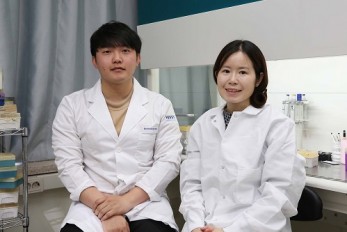
On-chip Drug Screening for Identifying Antibiotic ..
(from left: Seunggyu Kimand Professor Jessie Sungyun Jeon) A KAIST research team developed a microfluidic-based drug screening chip that identifies synergistic interactions between two antibiotics in eight hours. This chip can be a cell-based drug screening platform for exploring critical pharmacological patterns of antibiotic interactions, along with potential applications in screening other cell-type agents and guidance for clinical therapies. Antibiotic susceptibility testing, which determines types and doses of antibiotics that can effectively inhibit bacterial growth, has become more critical in recent years with the emergence of antibiotic-resistant pathogenic bacteria strains. To overcome the antibiotic-resistant bacteria, combinatory therapy using two or more kinds of antibiotics has been gaining considerable attention. However, the major problem is that this therapy is not always effective; occasionally, unfavorable antibiotic pairs may worsen results, leading to suppressed antimicrobial effects. Therefore, combinatory testing is a crucial preliminary process to find suitable antibiotic pairs and their concentration range against unknown pathogens, but the conventional testing methods are inconvenient for concentration dilution and sample preparation, and they take more than 24 hours to produce the results. To reduce time and enhance the efficiency of combinatory testing, Professor Jessie Sungyun Jeon from the Department of Mechanical Engineering, in collaboration with Professor Hyun Jung Chung from the Department of Biological Sciences, developed a high-throughput drug screening chip that generates 121 pairwise concentrations between two antibiotics. The team utilized a microfluidic chip with a sample volume of a few tens of microliters. This chip enabled 121 pairwise concentrations of two antibiotics to be automatically formed in only 35 minutes. They loaded a mixture of bacterial samples and agarose into the microchannel and injected reagents with or without antibiotics into the surrounding microchannel. The diffusion of antibiotic molecules from the channel with antibiotics to the one without antibiotics resulted in the formation of two orthogonal concentration gradients of the two antibiotics on the bacteria-trapping agarose gel. The team observed the inhibition of bacterial growth by the antibiotic orthogonal gradients over six hours with a microscope, and confirmed different patterns of antibiotic pairs, classifying the interaction types into either synergy or antagonism. Professor Jeon said, “The feasibility of microfluidic-based drug screening chips is promising, and we expect our microfluidic chip to be commercialized and utilized in near future.” This study, led by Seunggyu Kim, was published in Lab on a Chip (10.1039/c8lc01406j) on March 21, 2019. Figure 1. Back cover image for the “Lab on a Chip”. Figure 2. Examples of testing results using the microfluidic chips developed in this research.
-
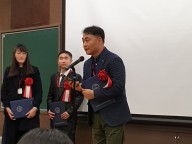
Professor Seoktae KANG received an IDEA award from..
Seoktae KANG, an associate professor at the department of civil and environmental engineering, received JSWE-IDEA prize in March 8th at the spring conference of JSWE (Japan society of water environment). This award is supported by IDEA consulting group in Japan, and the award is given to middle-career Asian researchers on water engineering during the annual conference of JSWE. At the 2019 award ceremony, Prof. Kang presented his research work entitled “Ultra-fast electrochemical oxidation of micropollutants by flow-through conductive membrane system”, which proposed novel application of carbon nanotube-based hollow membrane-type electrodes to overcome the oxidation of electrodes, side-reaction of intermediates, and mass-transfer limitation of the existing system.
-
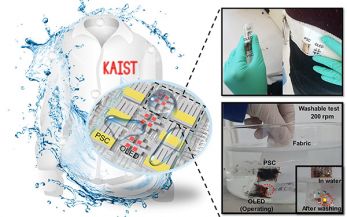
True-meaning Wearable Displays: Self-powered, Wash..
(Video: The washing process of wearing display module) When we think about clothes, they are usually formed with textiles and have to be both wearable and washable for daily use; however, smart clothing has had a problem with its power sources and moisture permeability, which causes the devices to malfunction. This problem has now been overcome by a KAIST research team, who developed a textile-based wearable display module technology that is washable and does not require an external power source. To ease out the problem of external power sources and enhance the practicability of wearable displays, Professor Kyung Cheol Choi from the School of Electrical Engineering and his team fabricated their wearing display modules on real textiles that integrated polymer solar cells (PSCs) with organic light emitting diodes (OLEDs). PSCs have been one of the most promising candidates for a next-generation power source, especially for wearable and optoelectronic applications because they can provide stable power without an external power source, while OLEDs can be driven with milliwatts. However, the problem was that they are both very vulnerable to external moisture and oxygen. The encapsulation barrier is essential for their reliability. The conventional encapsulation barrier is sufficient for normal environments; however, it loses its characteristics in aqueous environments, such as water. It limits the commercialization of wearing displays that must operate even on rainy days or after washing. To tackle this issue, the team employed a washable encapsulation barrier that can protect the device without losing its characteristics after washing through atomic layer deposition (ALD) and spin coating. With this encapsulation technology, the team confirmed that textile-based wearing display modules including PSCs, OLEDs, and the proposed encapsulation barrier exhibited little change in characteristics even after 20 washings with 10-minute cycles. Moreover, the encapsulated device operated stably with a low curvature radius of 3mm and boasted high reliability. Finally, it exhibited no deterioration in properties over 30 days even after being subjected to both bending stress and washing. Since it uses a less stressful textile, compared to conventional wearable electronic devices that use traditional plastic substrates, this technology can accelerate the commercialization of wearing electronic devices. Importantly, this wearable electronic device in daily life can save energy through a self-powered system. Professor Choi said, “I could say that this research realized a truly washable wearable electronic module in the sense that it uses daily wearable textiles instead of the plastic used in conventional wearable electronic devices. Saving energy with PSCs, it can be self-powered, using nature-friendly solar energy, and washed. I believe that it has paved the way for a ‘true-meaning wearable display’ that can be formed on textile, beyond the attachable form of wearable technology.” This research, in collaboration with Professor Seok Ho Cho from Chonnam National University and led by Eun Gyo Jeong, was published in Energy and Environmental Science (10.1039/c8ee03271h) on January 18, 2019. Figure 1. Schematic and photo of a washable wearing display module Figure 2. Cover page of Energy and Environmental Science
-
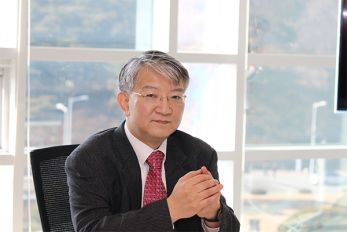
Distinguished Professor Sang Yup Lee Honored with ..
(Distinguished Professor Sang Yup Lee from the Department of Chemical and Biomolecular Engineering) Distinguished Professor Sang Yup Lee from the Department of Chemical and Biomolecular Engineering was honored to be the laureate of the 23rd NAEK Award. The NAEK (National Academy of Engineering of Korea) Award was instituted in 1997 to honor and recognize engineers who have made significant contributions to the development of the engineering and technology field at universities, industries, and institutions. Every year, it is conferred to only one person who has achieved original and world-leading research that has led to national development. Distinguished Professor Lee is a pioneering scholar of the field of systems metabolic engineering and he was recognized for his significant achievements in the biochemical industry by developing novel microbial bioprocesses. In particular, he is globally renowned for biological plastic synthesis, making or decomposing polymers with microorganisms instead of using fossil resources. He has produced numerous high-quality research breakthroughs in metabolic and systems engineering. In 2016, he produced an easily degradable plastic with Escherichia coli (E. coli). In 2018, he successfully produced aromatic polyesters, the main material for PET (poly ethylene terephthalate) from E. coli strains. He also identified microorganism structures for PET degradation and improved its degradability with a novel variant. His research was ranked number one in the research and development division of Top Ten Science and Technology News 2018 announced by Korean Federation of Science & Technology Societies. He is one of highly cited researchers (HCR) ranked in the top 1% by citations for their field by the Clarivate Analytics.
-

The Future Mobility of the Year 2019
KAIST announced the Future Mobility of the Year (FMOTY) 2019. The winners are Volvo 360C, Toyota e-Palette, and Toyota Concept-i WALK. FMOTY are the first awards that recognizes concept cars that exhibit innovative services and practical transportation technology in three categories: private mobility, public and commercial mobility, and personal mobility. Figure 1. The winner in the private mobility division, the Volvo 360C In the private mobility division, the award went to the Volvo 360C. With targeted routes of roughly 186 miles, this vehicle has an ambitious service goal to replace airplanes by traveling these routes with great comfort. Goro Okazaki, a journalist with Car and Driver Japan, said, “The Volvo 360C clearly shows how highly personalized autonomous driving can change the future.” Figure 2. The winner in the public mobility division, the Toyota e-Palette The Toyota e-Palette was the winning car in commercial mobility division. This vehicle provides the best solution as a mobile service platform by transforming itself into mobile hospitals, hotels, stores and food trucks. Carlo Calderón, a journalist for Autopista Spain, said, “It has a great strength in remodeling its indoor and outdoor spaces according to various commercial uses.” Figure 3. The winner in the personal mobility division, the Toyota Concept-i WALK In the personal mobility division, the award went to the Toyota Concept-i WALK. It was recognized for having an exquisite user environment and artificial intelligent agent, along with an excellent completion. Jun Miao, a journalist with MJ CarShow China, said, “It is aesthetically pleasing. Beyond the upright control of conventional personal mobility, it allows agile control with a joystick.” FMOTY conducted a screening process for 45 concept cars over three months and 16 renowned automotive experts from 11 countries participated as judges for this award, including Editor in Chief of BBC Top Gear Magazine Charlie Turner and European Bureau Chief of Automobile Magazine Georg Kacher. The judges said that FMOTY was born to propose a new aspect of future mobility, and in terms of evaluating technical and social values of concept cars, FMOTY carries great significance. Kyung-soo Kim, Dean of the Cho Chun Shik Graduate School of Green Transportation said, “Globally renowned experts in the automotive field participated as judges to elevate the prestige and fairness of the awards. KAIST members were excluded from the entire judging process. I believe that the FMOTY Awards will expand public attention from the present to the future.” Details can be found on the official website of FMOTY ( www.fmoty.org ).
-

Unravelling Inherent Electrocatalysis to Improve t..
(Figure 1. Electrode structure for the precise evaluation of the metal nanoparticles’ electrochemical catalytic characteristics at a high temperature.) A KAIST team presented an ideal electrode design to enhance the performance of high-temperature fuel cells. The new analytical platform with advanced nanoscale patterning method quantitatively revealed the electrochemical value of metal nanoparticles dispersed on the oxide electrode, thus leading to electrode design directions that can be used in a variety of eco-friendly energy technologies. The team, working under Professor WooChul Jung and Professor Sang Ouk Kim at the Department of Materials Science and Engineering, described an accurate analysis of the reactivity of oxide electrodes boosted by metal nanoparticles, where all particles participate in the reaction. They identified how the metal catalysts activate hydrogen electro-oxidation on the ceria-based electrode surface and quantify how rapidly the reaction rate increases with the proper choice of metals. Metal nanoparticles with diameters of 10 nanometers or less have become a key component in high-performance heterogeneous catalysts, primarily serving as a catalytic activator. Recent experimental and theoretical findings suggest that the optimization of the chemical nature at the metal and support interfaces is essential for performance improvement. However, the high cost associated with cell fabrication and operation as well as poorer stability of metal nanoparticles at high temperatures have been a long-standing challenge. To solve this problem, the team utilized a globally recognized metal nano patterning technology that uses block copolymer self-assembled nano templates and succeeded in uniformly synthesizing metal particles 10 nanometers in size on the surface of oxide fuel cell electrodes. They also developed a technology to accurately analyze the catalyst characteristics of single particles at high temperatures and maximize the performance of a fuel cell with minimal catalyst use. The research team confirmed that platinum, which is a commonly used metal catalyst, could boost fuel cell performance by as much as 21 times even at an amount of 300 nanograms, which only costs about 0.015 KRW. The team quantitatively identified and compared the characteristics of widely used metal catalysts other than platinum, such as palladium, gold, and cobalt, and also elucidated the precise principle of catalyst performance through theoretical analysis. (Figure 2. Comparison of the electrochemical catalytic characteristics for various 10nm metal nanoparticles (platinum, palladium, cobalt, gold) at a high temperature.) Professor Jung said, "We have broken the conventional methods of increasing the amount of catalyst which have deemed inefficient and expensive. Our results suggest a clear idea for high performance fuel cells using very small amounts of nanoparticles. This technology can be applied to many different industrial fields, advancing the commercialization of eco-friendly energy technologies such as fuel cells that generate electricity and electrolytic cells that produce hydrogen from water.” The research has been published as the cover article of Nature Nanotechnology in the March issue. This research was carried out with support from the Nano-Material Technology Development Program through the National Research Foundation of Korea.
-

Wafer-scale multilayer fabrication of silk fibroin..
A KAIST research team developed a novel fabrication method for the multilayer processing of silk-based microelectronics. This technology for creating a biodegradable silk fibroin film allows microfabrication with polymer or metal structures manufactured from photolithography. It can be a key technology in the implementation of silk fibroin-based biodegradable electronic devices or localized drug delivery through silk fibroin patterns. Silk fibroins are biocompatible, biodegradable, transparent, and flexible, which makes them excellent candidates for implantable biomedical devices, and they have also been used as biodegradable films and functional microstructures in biomedical applications. However, conventional microfabrication processes require strong etching solutions and solvents to modify the structure of silk fibroins. To prevent the silk fibroin from being damaged during the process, Professor Hyunjoo J. Lee from the School of Electrical Engineering and her team came up with a novel process, named aluminum hard mask on silk fibroin (AMoS), which is capable of micropatterning multiple layers composed of both fibroin and inorganic materials, such as metal and dielectrics with high-precision microscale alignment. The AMoS process can make silk fibroin patterns on devices, or make patterns on silk fibroin thin films with other materials by using photolithography, which is a core technology in the current microfabrication process. The team successfully cultured primary neurons on the processed silk fibroin micro-patterns, and confirmed that silk fibroin has excellent biocompatibility before and after the fabrication process and that it also can be applied to implanted biological devices. Through this technology, the team realized the multilayer micropatterning of fibroin films on a silk fibroin substrate and fabricated a biodegradable microelectric circuit consisting of resistors and silk fibroin dielectric capacitors in a silicon wafer with large areas. They also used this technology to position the micro-pattern of the silk fibroin thin film closer to the flexible polymer-based brain electrode, and confirmed the dye molecules mounted on the silk fibroin were transferred successfully from the micropatterns. Professor Lee said, “This technology facilitates wafer-scale, large-area processing of sensitive materials. We expect it to be applied to a wide range of biomedical devices in the future. Using the silk fibroin with micro-patterned brain electrodes can open up many new possibilities in research on brain circuits by mounting drugs that restrict or promote brain cell activities.” This research, in collaboration with Dr. Nakwon Choi from KIST and led by PhD candidate Geon Kook, was published in ACS AMI (10.1021/acsami.8b13170) on January 16, 2019. Figure 1. The cover page of ACS AMI Figure 2. Fibroin microstructures and metal patterns on a fibroin produced by using the AMoS mask. Figure 3. Biocompatibility assessment of the AMoS Process. Top: Schematics image of a) fibroin-coated silicon b) fibroin-pattered silicon and c) gold-patterned fibroin. Bottom: Representative confocal microscopy images of live (green) and dead (red) primary cortical neurons cultured on the substrates.
-
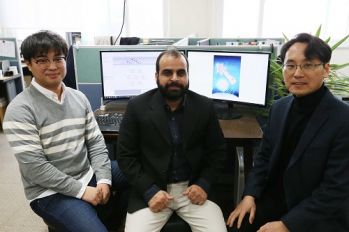
Novel Material Properties of Hybrid Perovskite Nan..
(from left: Juho Lee, Dr. Muhammad Ejaz Khan and Professor Yong-Hoon Kim) A KAIST research team reported a novel non-linear device with the founding property coming from perovskite nanowires. They showed that hybrid perovskite-derived, inorganic-framework nanowires can acquire semi-metallicity, and proposed negative differential resistance (NDR) devices with excellent NDR characteristics that resulted from a novel quantum-hybridization NDR mechanism, implying the potential of perovskite nanowires to be realized in next-generation electronic devices. Organic-inorganic hybrid halide perovskites have recently emerged as prominent candidates for photonic applications due to their excellent optoelectronic properties as well as their low cost and facile synthesis processes. Prominent progresses have been already made for devices including solar cells, light-emitting diodes, lasers and photodetectors. However, research on electronic devices based on hybrid halide perovskites has not been actively pursued compared with their photonic device counterparts. Professor Yong-Hoon Kim from the School of Electrical Engineering and his team took a closer look at low-dimensional organic-inorganic halide perovskite materials, which have enhanced quantum confinement effects, and particularly focused on the recently synthesized trimethylsulfonium (TMS) lead triiodide (CH3)3SPbI3. Using supercomputer simulations, the team first showed that stripping the (CH3)3S or TMS organic ligands from the TMS PbI3 perovskite nanowires results in semi-metallic PbI3 columns, which contradicts the conventional assumption of the semiconducting or insulating characteristics of the inorganic perovskite framework. Utilizing the semi-metallic PbI3 inorganic framework as the electrode, the team designed a tunneling junction device from perovskite nanowires and found that they exhibit excellent nonlinear negative differential resistance (NDR) behavior. The NDR property is a key to realizing next-generation, ultra-low-power, and multivalued non-linear devices. Furthermore, the team found that this NDR originates from a novel mechanism that involves the quantum-mechanical hybridization between channel and electrode states. Professor Kim said, “This research demonstrates the potential of quantum mechanics-based computer simulations to lead developments in advanced nanomaterials and nanodevices. In particular, this research proposes a new direction in the development of a quantum mechanical tunneling device, which was the topic for which the Nobel Laureate in Physics in 1973 was awarded to Dr. Leo Esaki. This research, led by Dr. Muhammad Ejaz Khan and PhD candidate Juho Lee, was published online in Advanced Functional Materials (10.1002/adfm.201807620) on January 7, 2019. Figure. The draft version of the cover page of 'Advanced Functional Materials'
-
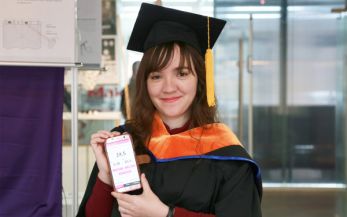
Kimchi Toolkit by Costa Rican Summa Cum Laude Help..
(Maria Jose Reyes Castro with her kimchi toolkit application) Every graduate feels a special attachment to their school, but for Maria Jose Reyes Castro who graduated summa cum laude in the Department of Industrial Design this year, KAIST will be remembered for more than just academics. She appreciates KAIST for not only giving her great professional opportunities, but also helping her find the love of her life. During her master’s course, she completed an electronic kimchi toolkit, which optimizes kimchi’s flavor. Her kit uses a mobile application and smart sensor to find the fermentation level of kimchi by measuring its pH level, which is closely related to its fermentation. A user can set a desired fermentation level or salinity on the mobile application, and it provides the best date to serve it. Under the guidance of Professor Daniel Saakes, she conducted research on developing a kimchi toolkit for beginners (Qualified Kimchi: Improving the experience of inexperienced kimchi makers by developing a monitoring toolkit for kimchi). “I’ve seen many foreigners saying it’s quite difficult to make kimchi. So I chose to study kimchi to help people, especially those who are first-experienced making kimchi more easily,” she said. She got recipes from YouTube and studied fermentation through academic journals. She also asked kimchi experts to have a more profound understanding of it. Extending her studies, she now works for a startup specializing in smart farms after starting last month. She conducts research on biology and applies it to designs that can be used practically in daily life. Her tie with KAIST goes back to 2011 when she attended an international science camp in Germany. She met Sunghan Ro (’19 PhD in Nanoscience and Technology), a student from KAIST and now her husband. He recommended for her to enroll at KAIST because the school offers an outstanding education and research infrastructure along with support for foreign students. At that time, Castro had just begun her first semester in electrical engineering at the University of Costa Rica, but she decided to apply to KAIST and seek a better opportunity in a new environment. One year later, she began her fresh start at KAIST in the fall semester of 2012. Instead of choosing her original major, electrical engineering, she decided to pursue her studies in the Department of Industrial Design, because it is an interdisciplinary field where students get to study design while learning business models and making prototypes. She said, “I felt encouraged by my professors and colleagues in my department to be creative and follow my passion. I never regret entering this major.” When Castro was pursuing her master’s program in the same department, she became interested in interaction designs with food and biological designs by Professor Saakes, who is her advisor specializing in these areas. After years of following her passion in design, she now graduates with academic honors in her department. It is a bittersweet moment to close her journey at KAIST, but “I want to thank KAIST for the opportunity to change my life for the better. I also thank my parents for being supportive and encouraging me. I really appreciate the professors from the Department of Industrial Design who guided and shaped who I am,” she said. Figure 1. The concept of the kimchi toolkit Figure 2. The scenario of the kimchi toolkit
-
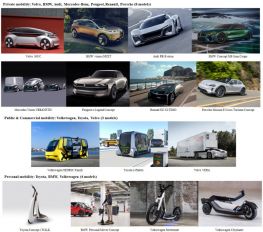
The First Award for Concept Cars, Future Mobility ..
KAIST will host an award to recognize the most visionary and inspiring concept cars of the year. The ‘Future Mobility of the Year (FMOTY)’ Awards recognize concept cars that have made outstanding contributions to future mobility. The first awards ceremony will take place in Korea in March 2019. The awards will be given to concept cars that exhibit innovative services and practical transportation technology in three categories: private mobility, public and commercial mobility, and personal mobility. To ensure a fair judging process, the contest invited influential and eminent journalists in the automotive field. They will evaluate the social values and innovative contributions of the concept cars that will pave the way for next-generation transportation. Concept cars have been neglected in existing automobile awards, such as the ‘Car of the Year’ because they have been considered experimental prototypes only built for showcasing a new vision for the quite far future. The FMOTY Awards will brings concept cars back into the spotlight and showcase the best ideas and social values of mind-blowing concept cars. Among 45 concept cars, fifteen candidates were selected as finalists after the initial screening that took place over the last three months: including models from Audi, BMW, Mercedes-Benz, Peugeot, Porsche, Renault, Toyota, Volkswagen, and Volvo. The winners will be announced and awarded in Seoul on March 28th. Kyung-soo Kim, Dean of the Cho Chun Shik Graduate School of Green Transportation which organizes the award said, “As the automobile industry undergoes an era of transformation, it is crucial to recognize the efforts of automobile companies who are making attempts to create novel forms of mobility. That is why we launched the FMOTY Awards, hoping to add a future-oriented spirit to the existing awards that consider finished vehicles only. By selecting the best concept car, the FMOTY Awards will expand public attention from the present to the future.” Details can be found on the official website of FMOTY ( www.fmoty.org), where photos of the finalists are also available for download ( http://bitly.kr/JTUUp). Figure 1. Finalists for the 'Future Mobility of the Year'
-
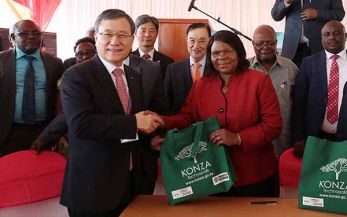
Kenya-KAIST Kicks off with a 95-Million USD Fundin..
KAIST, founded through a six-million USD loan from USAID in 1971, to provide turnkey-based education consultancy for Kenya’s first advanced science and technology institute. KAIST and the Konza Technopolis Development Authority (KoTDA) announced the official establishment of Kenya-KAIST by 2021 during a kickoff ceremony on February 12 in Kenya. The KAIST delegation headed by President Sung-Chul Shin and Kenyan cabinet members and dignitaries including Minister of Education Amina Mohamed, the Chairman of the KoTDA Reuben Mutiso, and the CEO of KoTDA John Tanui attended the ceremony. With this kickoff held at Konza Technopolis Malili, KAIST, the first and top science and technology university in Korea, will participate in Kenya’s strategic economic development plan with the provision of a turnkey-based science and technology education consultancy for the establishment of Kenya’s first advanced institute of science and technology. KAIST, which won preferred bidder status in consortium with Samwoo and Sunjin architecture and engineering companies, signed the contract with the KoTDA last November. Korea Eximbank will offer a 95-million USD economic development cooperation fund loan to the Kenyan government. The campus will be constructed in the Konza Techno City located near Nairobi by 2021, with the first batch of 200 graduate students starting classes in 2022. KAIST will develop academic curricula for six initial departments (Mechanical Engineering, Electrical/Electronic Engineering, ICT Engineering, Chemical Engineering, Civil Engineering, and Agricultural Biotechnology), which will lay the groundwork for engineering research and education in Kenya to meet emerging socioeconomic demands. In addition, KAIST will provide education in the basic science areas of math, physics, chemistry, and biology for students. The Kenyan government plans to transform Kenya into a middle-income country under Vision 2030 through the promotion of science, technology, and innovation for national economic growth. Nicknamed Africa’s Silicon Savannah, Konza Techno City is a strategic science and technology hub constructed to realize this vision. To this end, the medium-term plan set a goal to provide specialized research and training in various cutting-edge engineering and advanced science fields. It is also notable that the Kenyan government asked to develop an industry-academy cooperation program in the Konza Techno City. This reflects the high expectations for Kenya-KAIST and its role as a growth engine in the center of the Konza Technopolis. It is anticipated that the technopolis will create 16,675 jobs in the medium term and over 200,000 upon completion, positioning Kenya as an ICT hub within the region. Saying that the partnership through Kenya-KAIST will bring a new future to Kenya as well as KAIST at the ceremony, President Shin reflected that the project will be a significant milestone for KAIST’s history and global competitiveness. He added, “With this Kenya project, we come to share the past, present, and future of KAIST. And I am very pleased to celebrate our shared vision: the empowerment of science, technology, and education.” In particular, President Shin was accompanied by Dr. Kun-Mo Chung, a founding provost who served as the Minister of Science and Technology in Korea twice. He now serves as an advisor to Kenyan President Uhuru Kenyatta. Dr. Chung had played a crucial role in securing a six-million USD loan from US AID to the Korean government to establish KAIST in 1971. He proposed the idea to establish an advanced science and technology institute in Korea to Dr. John Hannah, then the director of US AID. The seed that was sowed five decades ago in Korea by Dr. Chung has now fully bloomed in Kenya. In only a half century, KAIST has become a donor institution that passes on science and technology education systems including the construction of campuses to developing countries. KAIST has been acclaimed as US AID’s most successful foreign aid project. A report from the National Academy of Sciences in the US described KAIST as an exemplary case in which a former recipient of international aid has grown to become a science, technology and innovation leader. The kickoff of Kenya-KAIST drew the attention of both media and local universities in Kenya, attesting to their strong interest to drive economic growth through advanced science and technology. The University of Nairobi also hosted a special lecture by President Shin, asking him to share the recipe for the success of KAIST in Korea. In a lecture titled “A Crucial Engine for Rapid National Development,” President Shin presented the vision, innovation, and passion of the Korean people that led to the phenomenal results we can see today. The successful case of KAIST has been benchmarked by many countries for years. For instance, KAIST set up the curriculum for the nuclear engineering program at the Khalifa University of Science and Technology in UAE in 2010. Since 2015, Chongquing University of Technology in China has been running its electrical engineering and computer science programs based on the educational systems and curricula offered by KAIST. Last October, KAIST also signed an MOU with the Prince Mohammad Bin Salman College of Cyber Security, AI, and Advanced Technologies in Saudi Arabia to provide the undergraduate program for robotics. Among all these programs benchmarking KAIST, Kenya-KAIST clearly stands out, as it carries out a turnkey-based project that encompasses every aspect of institution building, ranging from educational curricular development to campus construction and supervision. Figure 1. KAIST President Sung-Chul Shin and Principal Secretary of Ministry of Education Collette A. Suda Figure 2. Kickoff Ceremony of Kenya-KAIST Figure 3. Conceptual image of Kenya KAIST

